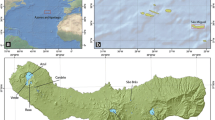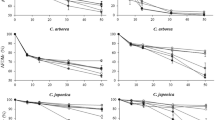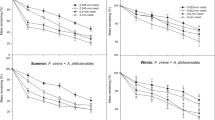Abstract
One of the most important sources of energy in aquatic ecosystems is the allochthonous input of detritus. Replacement of native tree species by exotic ones affects the quality of detritus entering freshwater ecosystems. This replacement can alter nutrient cycles and community structure in aquatic ecosystems. The aims of our study were (1) to compare leaf litter decomposition of two widely distributed exotic species (Ailanthus altissima and Robinia pseudoacacia) with the native species they coexist with (Ulmus minor and Fraxinus angustifolia), and (2) to compare macroinvertebrate colonization among litters of the invasive and native species. Litter bags of the four tree species were placed in the water and collected every 2, 25, 39, 71, and 95 days in a lentic ecosystem. Additionally, the macroinvertebrate community on litter bags was monitored after 25, 39, and 95 days. Several leaf chemistry traits were measured at the beginning (% lignin; lignin:N, C:N, LMA) and during the study (leaf total nitrogen). We detected variable rates of decomposition among species (k values of 0.009, 0.008, 0.008, and 0.005 for F. angustifolia, U. minor, A. altissima and R. pseudoacacia, respectively), but we did not detect an effect of litter source (from native/exotic). In spite of its low decay, the highest leaf nitrogen was found in R. pseudoacacia litter. Macroinvertebrate communities colonizing litter bags were similar across species. Most of them were collectors (i.e., they feed on fine particulate organic matter), suggesting that leaf material of either invasive or native trees was used as substrate both for the animals and for the organic matter they feed on. Our results suggest that the replacement of the native Fraxinus by Robinia would imply a reduction in the rate of leaf processing and also a slower release of leaf nitrogen to water.


Similar content being viewed by others
References
Allan DJ, Castillo MM (2007) Stream ecology: structure and function of running waters, 2nd edn. Springer, Berlin Heidelberg New York
Bärlocher F (2005) Leaf mass loss estimated by litter bag technique. In: Graça MAS, Bärlocher F, Gessner M (eds) Methods to study litter decomposition: a practical guide, pp 37–42
Bärlocher F, Graça MAS (2002) Exotic riparian vegetation lowers fungal diversity but not leaf decomposition in Portuguese streams. Freshw Biol 47:1123–1135. doi:10.1046/j.1365-2427.2002.00836.x
Bird GA, Kaushik NK (1985) Processing of elm and maple leaf-disks by collectors and shredders in laboratory feeding studies. Hydrobiologia 126:109–120. doi:10.1007/BF00008677
Boring LR, Swank WT (1984) The role of black locust (Robinia pseudoacacia) in forest succession. J Ecol 72:749–766
Castro-Díez P, González-Muñoz N, Alonso A, Gallardo A, Poorter L (2009) Effects of exotic invasive trees on nitrogen cycling: a case study in central Spain. Biol Invasions 11:1973–1986. doi:10.1007/s10530-008-9374-3
Choong MF, Lucas PW, Ong JSY, Pereira B, Tan HTW, Turner IM (1992) Leaf fracture toughness and sclerophylly: their correlation and ecological implications. New Phytol 121:597–610. doi:10.1111/j.1469-8137.1992.tb01131.x
Chytry M, Pysek P, Wild J, Pino J, Maskell LC, Vila M (2009) European map of alien plant invasions based on the quantitative assessment across habitats. Divers Distrib 15:98–107. doi:10.1111/j.1472-4642.2008.00515.x
Cummins KW (1974) Structure and function of stream ecosystems. Bioscience 24:631–641
Cummins KW, Wilzbach MA, Gates DM, Perry JB, Taliferro WB (1989) Shredders and riparian vegetation—leaf litter that falls into streams influences communities of stream invertebrates. Bioscience 39:24–30
DAISIE, European Invasive Alien Species Gateway (2009) (http://www.europe-aliens.org)
Driebe EM, Whitham TG (2000) Cottonwood hybridization affects tannin and nitrogen content of leaf litter and alters decomposition. Oecologia 123:99–107. doi:10.1007/s004420050994
Ehrenfeld JG (2003) Effects of exotic plant invasions on soil nutrient cycling processes. Ecosystems 6:503–523
Enriquez S, Duarte CM, Sandjensen K (1993) Patterns in decomposition rates among photosynthetic organisms—the importance of detritus C-N-P content. Oecologia 94:457–471
Friberg N, Jacobsen D (1994) Feeding plasticity of 2 detriviore-shredders. Freshw Biol 32:133–142. doi:10.1111/j.1365-2427.1994.tb00873.x
Gessner MO, Chauvet E (1994) Importance of stream microfungi in controlling breakdown rates of leaf-litter. Ecology 75:1807–1817. doi:10.2307/1939639
Graça MAS (2001) The role of invertebrates on leaf litter decomposition in streams—A review. Int Rev Hydrobiol 86:383–393
Graça MAS, Cressa C, Gessner MO, Feio MJ, Callies KA, Barrios C (2001) Food quality, feeding preferences, survival and growth of shredders from temperate and tropical streams. Freshw Biol 46:947–957. doi:10.1046/j.1365-2427.2001.00729.x
Harner MJ, Crenshaw CL, Abelho M, Stursova M, Shah JFJ, Sinsabaugh RL (2009) Decomposition of leaf litter from a native tree and an actinorhizal invasive across riparian habitats. Ecol Appl 19:1135–1146. doi:10.1890/08-0294.1
Kowarik I, Saumel I (2007) Biological flora of central Europe: Ailanthus altissima (Mill.) Swingle. Perspect Plant Ecol Evol Syst 8:207–237. doi:10.1016/j.ppees.2007.03.002
Landau S, Everitt BS (2004) A handbook of statistical analyses using SPSS. CRC Press, Boca Raton
Leps J, Smilauer P (2003) Multivariate analysis of ecological data using CANOCO. Cambridge University Press, UK
Naiman RJ, Décamps H (1997) The ecology of interfaces: Riparian zones. Annu Rev Ecol Evol Syst 28:621–658. doi:10.1146/annurev.ecolsys.28.1.621
Reinhart KO, VandeVoort R (2006) Effect of native and exotic leaf litter on macroinvertebrate communities and decomposition in a western Montana stream. Divers Distrib 12:776–781. doi:10.1111/j.1472-4642.2006.00252.x
Richardson DM, Holmes PM, Esler KJ, Galatowitsch SM, Stromberg JC, Kirkman SP, Pysek P, Hobbs RJ (2007) Riparian vegetation: degradation, alien plant invasions, and restoration prospects. Divers Distrib 13:126–139. doi:10.1111/j.1366-9516.2006.00314.x
Royer TV, Monaghan MT, Minshall GW (1999) Processing of native and exotic leaf litter in two Idaho (USA) streams. Hydrobiologia 400:123–128. doi:10.1023/A:1003703130930
Sanz Elorza M, Dana Sánchez ED, Sobrino Vesperinas E (2004) Atlas de las plantas alóctonas invasoras en España. Dirección General para la Biodiversidad. Ministerio de Medio Ambiente, Madrid
Suberkropp K (1998) Effect of dissolved nutrients on two aquatic hyphomycetes growing on leaf litter. Mycol Res 102:998–1002
Suberkropp K, Chauvet E (1995) Regulation of leaf breakdown by fungi in streams: influences of water chemistry. Ecology 76:1433–1445
Swan CM, Healey B, Richardson DC (2008) The role of native riparian tree species in decomposition of invasive tree of heaven (Ailanthus altissima) leaf litter in an urban stream. Ecoscience 15:27–35
Webster JR, Benfield EF (1986) Vascular plant breakdown in freshwater ecosystems. Annu Rev Ecol Syst 17:567–594. doi:10.1146/annurev.es.17.110186.003031
Zhang D, Hui D, Luo Y, Zhou G (2008) Rates of litter decomposition in terrestrial ecosystems: global patterns and controlling factors. J Plant Ecol 1:85–93. doi:10.1093/jpe/rtn002
Acknowledgments
This study was supported by a research project CGL2007-61873/BOS of the Spanish Ministry of Science and Innovation (SMSI). Dr. Alvaro Alonso was supported by a postdoctoral contract (Juan de la Cierva) from SMSI, and by a grant from the Wageningen Institute for Environment and Climate Research (WIMEK) to stay at the Aquatic Ecology and Water Quality Management Group (Wageningen University, The Netherlands). Noelia González-Muñoz was supported by grants from SMSI. We acknowledge Rosendo Elvira and the staff of the Alcalá University Botanical Garden for their support to perform this experiment at the Botanical Garden Lake. Special thanks to Dr. Julio A. Camargo for allowing us to use limnological material.
Author information
Authors and Affiliations
Corresponding author
About this article
Cite this article
Alonso, A., González-Muñoz, N. & Castro-Díez, P. Comparison of leaf decomposition and macroinvertebrate colonization between exotic and native trees in a freshwater ecosystem. Ecol Res 25, 647–653 (2010). https://doi.org/10.1007/s11284-010-0698-y
Received:
Accepted:
Published:
Issue Date:
DOI: https://doi.org/10.1007/s11284-010-0698-y




